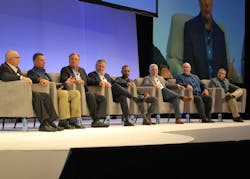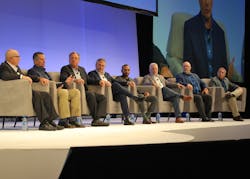The trends shaping tomorrow’s industrial facilities
Identifying the current drivers of the world’s process industries can be boiled down to three mega trends: Sustainability, digital transformation and flexible manufacturing. That was the consensus of an eight-person panel discussion during the opening session at Rockwell Automation’s Process Solutions User Group at Chicago’s McCormick Place on Monday.
“A keyword to all of this is that it is a journey,” said Jim Winter, Rockwell Automation’s director of global process business, emphasizing that change won’t be easy for many companies, and it will take a concerted effort to address all three trends.
Another panelist, Kumar Sokka, global business director for digital at Rockwell Automation, said his business often describes the process of industrial digitalization as “difficult digital” due to the commitment necessary.
“You can almost look at the workforce and categorize it as to how each of these trends affects it,” Resnick said. “When we talk about sustainability at the C-level, we spend a lot of time looking at things like net-zero, circular economy, energy saving. When we’re in the plant, it’s an operational resilience story.
“How do we compensate if there is another pandemic, or we’re cut off from our supply chain? Is there a plan and tools in place that we can go to, so we truly do have a sustainable plan?” he continued by asking hypothetically: “Do we have the right tools and technology in place knowing we might not have a workforce that’s able to support them?”
Resnick told the audience that digitally transforming a facility can help a workforce to reach heights it might not be prepared to reach. While the youngest generations of workers are also the most technically savvy, the right technology is still needed to help those workers be more productive.
“They might be great at Fortnite but when you say something like ‘cat cracker’ they’re completely lost,” he said.
When it comes to flexible manufacturing, Resnick added, manufacturers these days are required to look at their supply chains from a real-time perspective and be prepared to shift gears at a moment’s notice.
Sustainability front and center
Pete Morell, global OEM industry director, sustainability and process, at Rockwell Automation, picked up the discussion on sustainability by saying many new OEMs coming into the process industries, whether in energy or food processing, really understand their processes but don’t necessarily understand the automation involved. He said Rockwell’s work with such customers is centered around driving consistency, which he said can ease the burden.
He also said many can’t seem to hire enough workers to develop such consistency. “That’s where we advocate a concept around ‘connected workers,’” he said, describing a plant where there is a central control room and workers are able to communicate and work in tandem.
John Steckler, director, North American Process Automation at Archer Daniels Midland (ADM), a Chicago-based food processing corporation, said consumers around the world have made it clear that they expect the products they purchase to come from sustainable sources, produced by companies that share their values. “With our role in the food chain, we really have a responsibility to scale up our sustainability efforts to the ever-expanding needs of the global population,” he said of his company.
To accomplish its sustainability goals, Steckler said the company focuses on its supply chain, which are farmers. “We’re helping to enroll over two million acres in regenerative agriculture for low-carbon intensity products,” he said of his company’s efforts. He outlined several other key initiatives such as the company’s “Strive 35” commitment, which aims to decrease its greenhouse gas emissions 25% by 2035.
“That commitment also includes targets for reduction in energy, water intensity and diverting waste from landfills,” he added. “So, we are looking at scope 1, 2 and 3 emissions.”
He also said the company is involved in projects and joint ventures for the production of bioplastics and sustainable aviation fuel. In addition, he highlighted its “Project Subway,” which is a project to produce feedstock for renewable diesel fuel.
For the project, Steckler said ADM needs a highly automated plant in North Dakota, which it hopes to have in operation by next year’s harvest, although Steckler admitted the timeline is aggressive. Steckler said the process of automating the plant, while sustainable in scope, was “really digital transformation in the form of a brand-new plant.”
He also said that ongoing workforce challenges needed to be considered, and that the plan for the new plant redefines roles, something he said is becoming increasingly necessary in today’s world. “The operator of yesterday is probably not the operator of tomorrow,” he said. “All roles in a plant might be different than what we would call traditional roles in plant production.”
He pointed to the need for building much more automated unit controls. He added that things such as full plant production adjustments need to be based on demand or key performance indicators.
“With less human interaction, normal process changes,” he said.
Digital transformation
Getting started on the digital transformation journey is no easy feat. Sokka said, “If you look at the market, you can see how everyone wants to figure out how to get into digital transformation and figure out what the problems are to solve.
“Where we sit, right in the middle is trying to bring all of the hardware, software, domain expertise, services, and partner software technology together to solve value,” he continued as he discussed Rockwell’s approach to digital transformation. “Our biggest focus is ‘fast value.’”
He said their approach is to work with customers to figure out what they can digitalize over six to eight weeks and then how to scale the solution. This approach drives larger scale transformation, he said.
One industry that has an urgent need for digital transformation but has struggled to master finding the right value is oil and gas. Andrea Monte, vice president, digital automation solutions and services at Sensia, an oil and gas technology company that brings together real-time control and IoT technology from Rockwell Automation and pairs it with software and analytics from oilfield services giant SLB (formerly Schlumberger), said the oil and gas industry face three main obstacles to digital transformation.
First, he said the global nature of the oil and gas business means there are very different operating conditions in different countries that companies face. “That makes standardizing difficult,” he said.
He added that the lifecycle of an oilfield is measured in decades, so architecture gets outdated even though it is still in use. That means it might not be capable of being transformed easily.
Finally, he reiterated the theme of the panel and pointed to the industry’s “Great Crew Change.” Ironically, this is a reason for digital transformation to step up in pace, he said. “There’s an opportunity for digital technology to replace domain knowledge,” he said.
Flexible manufacturing
The driver behind flexible manufacturing is quite simply consumers. Consumers aren’t just seeking sustainable products they want increased functionality, said Mark Massey, global electrical and controls manager at Primient, a manufacturer of food and industrial products from plant-based and renewable sources. “All the while still purchasing products from their established brand,” he added. “This puts a lot of pressure on the manufacturing space to change production more frequently and get to quality standards more quickly.”
This evolving demand requires products to move quickly from plant floor to end consumer without increasing warehousing or tank space, and while reducing working capital, he added.
“It has to be about everyone working together up and down the supply chain and requires stakeholders to think holistically about their businesses,” Massey said.
He added the trend toward flexible manufacturing offers the opportunity to revolutionize how companies manage their production. More importantly, it offers the opportunity to build smarter facilities.
Tim Shope, vice president, digital transformation at Endress+Hauser, agreed, saying new plants will be built “very differently.” Shope added that flexible manufacturing needs to be accounted for when building plants because the possible lack of workforce in the future will require more automation and less direct human interaction. He cited new green hydrogen plants as examples of facilities coming online that will be more about the technology and less about how many people are needed to run it.
Both men agreed with the rest of the panelists that flexible manufacturing has already arrived and is here to stay.
“Flexible manufacturing is no longer a far-off wave but a tsunami that has already hit,” Massey said.
And, it goes hand-in-hand with the trends toward sustainability and digitalization in defining the future of the process industries.
Get the best of Automation Fair 2022
When the event comes to a close, the best, most important coverage will be compiled into a report. Register now to pre-order the report and be among the first to receive it in your inbox.
About the Author

Leaders relevant to this article:


